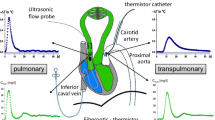Abstract
Using open chested dogs (n=12), we tested the hypothesis that the pulmonary capillary changes its caliber in response to alveolar hypoxia. Animals were placed in a left upright lateral position. Pulmonary perfusion was measured by electromagnetic flow transducers attached to the main and left pulmonary arteries. Systemic artery, pulmonary artery and pulmonary vein pressures were measured via catheters inserted into them. Shunt flow through the pulmonary capillary beds was evaluated by the microsphere method, injecting a mixture of three different size (3,9 and 15μm) redioactive microspheres into the inferior vena cava. Right one lung ventilation with left lung atelectasis or left lung insufflation of 5 cmH2O (O2 or He) was achieved by occluding the left main bronchus with a blocker attached to an endotracheal tube. Right one lung ventilation caused redistribution of the perfusion from the left lung to the right lung. Left pulmonary vascular resistance increased significantly, while total pulmonary vascular resistance showed no significant changes. The shunt ratios of the 3 and 9μm microspheres were not changed by right one lung ventilations with left lung atelectasis or insufflation. The shunt ratio of the 3μm microspheres through the left lung was significantly higher than that through two lungs during both the two lung and one lung ventilations. We concluded that caliber changes in the pulmonary capillary do not occur in response to alveolar hypoxia.
Similar content being viewed by others
References
Hakim TS, Michel RP, Minami H, Chang HK: Site of pulmonary hypoxic vasoconstriction studied with arterial and venous occlusion. J Appl Physiol 54:1298–1302, 1983
Kato M, Staub NC: Response of small pulmonary arteries to unilobar hypoxia and hypercapnia. Circ Res 19:426–440, 1966
Nagasawa Y, Bhattacharya J, Nanjo S, Gropper MA, Staub NC: Micropuncture measurement of lung microvascular pressure profile during hypoxia in cats. Circ Res 54:90–95, 1984
Shirai M, Sada K, Ninomiya I: Effects of regional alveolar hypoxia and hypercapnia on small pulmonary vessels in cats. J Appl Physiol 61:440–448, 1986
Kapanci Y, Assimacopolos A, Irel C, Zwahlen A, Fabbiani G: “Contractile interstitial cells” in pulmonary alveolar septa: a possible regulator of ventilation/perfusion ratio? J Cell BioI 60:375–392, 1974
Keys JR, Hetzel PS, Wood EH: Revised equations for calculation of blood flow and central blood volume from indicatordilution curves. J Appl Physiol 2:385–389, 1957
Guntheroth WG, Luchtel DL, Kawabori I: Pulmonary microcirculation: tubules rather than sheet and post. J Appl Physiol 53:510–515, 1982
Glazier JB, Hughes JMB, Maloney JE, West JB: Measurements of capillary dimensions and blood volume in rapidly frozen lungs. J Appl Physiol 26:65–76, 1969
Glazier JB, Murray JF: Sites of pulmonary vasomotor reactivity in the dog during alveolar hypoxia and serotonin and histamine infusion. J Clin Invest 50:2550–2556, 1971
Greenleaf JF, Ritman EL, Sass DJ, Wood EH: Spatial distribution of pulmonary blood flow in dogs in left decubitus position. Am J Physiol 227:230–244, 1974
Author information
Authors and Affiliations
About this article
Cite this article
Fujita, Y., Yano, H. & Takaori, M. Effects of alveolar hypoxia on pulmonary capillary beds. J Anesth 3, 194–199 (1989). https://doi.org/10.1007/s0054090030194
Received:
Accepted:
Published:
Issue Date:
DOI: https://doi.org/10.1007/s0054090030194



